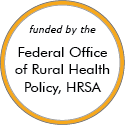Substance Use and Misuse in Rural Areas – Models and Innovations
These stories feature model programs and successful rural projects that can serve as a source of ideas and provide lessons others have learned. Some of the projects or programs may no longer be active. Read about the criteria and evidence-base for programs included.
Evidence-Based Examples
PROSPER Partnerships
Updated/reviewed June 2025
- Need: An approach to support sustained, quality delivery of evidence-based programs for youth and families in rural communities.
- Intervention: PROSPER, a program delivery system, guides communities in implementing evidence-based programs that build youth competencies, improve family functioning, and prevent risky behaviors, particularly substance use.
- Results: Youth in PROSPER communities reported delayed initiation of a variety of substances, lower levels of other behavioral problems, and improvements in family functioning and other life skills.
keepin' it REAL Rural
Updated/reviewed April 2025
- Need: A drug and alcohol prevention program for middle school students that is specific to rural culture.
- Intervention: An adaptation of the evidence-based keepin' it REAL curriculum was customized for rural middle school students.
- Results: Students showed a reduction in all substance use and less personal acceptability of substance use.
Effective Examples
Vermont Hub-and-Spoke Model of Care for Opioid Use Disorder
Updated/reviewed November 2025
- Need: In the early 2010s, needed increase access to medication treatment for opioid use disorder in rural Vermont.
- Intervention: 2012-2016 implementation of a statewide hub-and-spoke treatment access system.
- Results: The original system's increased treatment capacity and care coordination successes now are a permanent system of integrated care overseen by the Vermont state health department and Vermont Blueprint for Health.
Parent Partners
Updated/reviewed April 2025
- Need: To support parents whose children have been removed from the home so that the parents can make the changes needed for the children to return safely home.
- Intervention: A statewide program in Iowa pairs these parents with mentors who have successfully navigated their own child welfare cases.
- Results: Participants' children were more likely to return home than non-participants' children, and participants were less likely to have another child removal within a year of the child coming home.
Project Lazarus
Updated/reviewed May 2024
- Need: To reduce overdose-related deaths among prescription opioid users in rural Wilkes County, North Carolina.
- Intervention: Education and tools are provided for prescribers, patients and community members to lessen drug supply and demand, and to reduce harm in prescription opioid use.
- Results: Opioid overdose death rates have decreased in Wilkes County.
Promising Examples
Communities that Care Coalition
Updated/reviewed September 2025
- Need: To improve the health and well-being of young people in the rural area of Massachusetts's Franklin County and North Quabbin, and to reduce youth drug and alcohol use.
- Intervention: A community-based prevention coalition was formed to improve youth health and well-being and reduce youth drug and alcohol use. The coalition brings together stakeholders from across the community and uses the Communities That Care evidence-based community planning system.
- Results: CTC has seen significant reductions in substance abuse among local youth in the 30 rural towns they serve.
Nurse Navigator and Recovery Specialist Outreach Program

Updated/reviewed December 2024
- Need: To properly address and treat patients who have concurrent substance use disorders and chronic healthcare issues.
- Intervention: A referral system utilizes community health workers (CHWs) in a drug and alcohol treatment setting. A registered nurse helps with providers' medication-assisted treatment programs.
- Results: This program has reduced hospital emergency visits and hospital readmissions for patients since its inception.
Cross-Walk: Integrating Behavioral Health and Primary Care

Updated/reviewed May 2024
- Need: To address and treat substance use disorder (SUD) and depression in the Upper Great Lakes region.
- Intervention: Cross-Walk, a program that integrates behavioral healthcare into primary care services, was developed in Michigan's Marquette County.
- Results: The collaborative efforts strengthened care management services in local healthcare facilities as primary care patients were referred to a behavioral health specialist.
Contingency Management Smoking Cessation in Appalachia
Updated/reviewed June 2022
- Need: To reduce smoking rates of pregnant women and adolescents in Appalachian regions of eastern Kentucky and Ohio.
- Intervention: A web-based smoking cessation program that offered monetary incentives to reducing smoking.
- Results: Participants significantly reduced smoking rates or quit altogether.
Other Project Examples
Riverfront Talks: Substance Matters Podcast
Updated/reviewed December 2025
- Need: To reduce stigma around mental illness and substance use in North Carolina.
- Intervention: The Beaufort County Behavioral Health Task Force created the Riverfront Talks: Substance Matters podcast to interview people with lived experience.
- Results: As of December 2025, the podcast has 18 episodes.
Last Reviewed: 6/28/2023

